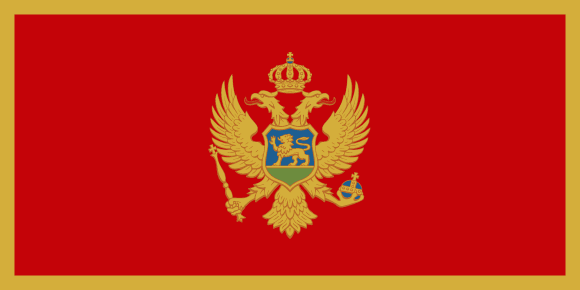Montenegro Flag

Montenegro's flag is crimson with a gold border and the national coat of arms of Montenegro in the center. It was formally adopted on July 13, 2004, when Montenegro was still a constituent of the Serbian-Montenegrin State Union. On September 16, 2004, the flag's specific requirements were defined.
The flag was preserved as the national flag after Montenegro proclaimed independence on June 3, 2006, as specified by Article 4 of Montenegro's Constitution, which was ratified in 2007. The flag's crimson field and golden border signify the country's history and culture, while the coat of arms in the middle symbolizes the nation's sovereignty and identity.
Montenegro flag downloads
- completely free for commercial and non-commercial use (public domain)
- based on vector file from Wikipedia Commons
- PNG or WebP format (lossless compression)
- Right click on the links (save link as)
| Width | Height | PNG | WebP |
|---|---|---|---|
| 20px | 10px | ~0.1 KB | ~0.1 KB |
| 40px | 20px | ~0.4 KB | ~0.1 KB |
| 80px | 40px | ~0.7 KB | ~0.1 KB |
| 160px | 80px | ~2.6 KB | ~0.6 KB |
| Width | Height | PNG | WebP |
|---|---|---|---|
| 16px | 12px | ~0.1 KB | ~0.1 KB |
| 40px | 30px | ~0.4 KB | ~0.1 KB |
| 80px | 60px | ~0.8 KB | ~0.1 KB |
| 128px | 96px | ~2.5 KB | ~0.6 KB |
- completely free for commercial and non-commercial use (public domain)
- based on vector file from Wikipedia Commons
- PNG, WebP (lossless compression) or JPEG format (100% quality)
- Right click on the links (save link as)
| Width | Height | PNG | WebP | JPEG |
|---|---|---|---|---|
| 2560px | 1280px | ~2.6 KB | ~0.6 KB | ~34.9 KB |
| 1280px | 640px | ~0.7 KB | ~0.1 KB | ~13.0 KB |
| 640px | 320px | ~0.4 KB | ~0.1 KB | ~5.6 KB |
| 320px | 160px | ~0.2 KB | ~0.1 KB | ~2.8 KB |
| 160px | 80px | ~0.1 KB | ~0.1 KB | ~1.5 KB |
| 80px | 40px | ~0.1 KB | ~0.1 KB | ~0.9 KB |
| 40px | 20px | ~0.1 KB | ~0.1 KB | ~0.6 KB |
| 20px | 10px | ~0.1 KB | ~0.1 KB | ~0.4 KB |
- completely free for commercial and non-commercial use (public domain)
- based on vector file from Wikipedia Commons
- SVG, PDF (Adobe Acrobat), AI (Adobe Ilustrator) or EPS format
- Right click on the links (save link as)
| Format | SVG | AI | EPS | |
|---|---|---|---|---|
| Vector download | ~0.3 KB | ~12.5 KB | ~29.7 KB | ~1533.8 KB |
Country information
Montenegro is a small country located in Southeastern Europe, bordered by Croatia to the west, Bosnia and Herzegovina to the northwest, Serbia to the northeast, Kosovo to the east, and Albania to the south. It has a population of about 620,000 people and its capital is Podgorica.
Montenegro has a rich and diverse history, with a mix of Slavic, Mediterranean, and other influences. The country was part of Yugoslavia until its breakup in the 1990s, and it declared independence in 2006. Today, Montenegro is a parliamentary republic with a president as its head of state and a prime minister as its head of government.
The economy of Montenegro is based on a mix of industries, including tourism, manufacturing, and agriculture. The country is known for its beautiful natural scenery, with a long Adriatic coastline, picturesque lakes and mountains, and national parks. It is a popular tourist destination, with a number of beaches, resorts, and cultural attractions.
The official language of Montenegro is Montenegrin, which is similar to Serbian, Croatian, and Bosnian. The population of Montenegro is predominantly Orthodox Christian, with a small minority of other religions. Montenegro has a rich cultural heritage, with a mix of Slavic, Mediterranean, and other influences. The country is known for its folk music, dance, and traditional crafts, such as woodcarving and weaving.
| Independent | Yes |
| Country codes | ME, MNE (ISO 3166-1) |
| Official name | Montenegro |
| Official languages | Montenegrin |
| Religion | 76.0% Christianity, 19.1% Islam, 1.3% No religion, 1.1% Others, 2.6% No answer |
| Capital city | Podgorica |
| Continent | Europe |
| Time zone | UTC+1 (CET) • Summer (DST) • UTC+2 (CEST) |
| Member of | United Nations |
| NATO | |
| Population | 628,270 (2023) |
| Population density | 47 per Km2 (121 people per mi2) |
| Urban Population | 67.6 % of the population is urban (424,767 people in 2020) |
| Migrants (net) | -480 |
| Median age | 38.8 years |
| Total area | The total land area is 13,450 Km2 (5,193 sq. miles) |
| Highest point | Zla Kolata (2 534 m, 8 314 ft) |
| Lowest point | Adriatic Sea |
| GDP per capita | $ 9,465 (World Bank, 2021) |
| Currency | Euro (€, EUR) |
| Calling code | +382 |
| Internet TLD | .me (click here to find and register domain name) |
| Country Wikipedia Page | Montenegro Wikipedia Page |
Main Cities by Population in Montenegro
| # | CITY NAME | POPULATION |
|---|---|---|
| 1 | Podgorica | 136,473 |
| 2 | Niksic | 58,212 |
| 3 | Herceg-Novi | 19,536 |
| 4 | Pljevlja | 19,489 |
| 5 | Budva | 18,000 |
| 6 | Bar | 17,727 |
| 7 | Bijelo Polje | 15,400 |
| 8 | Cetinje | 15,137 |
